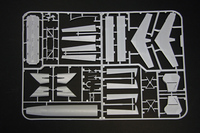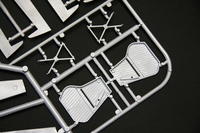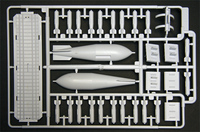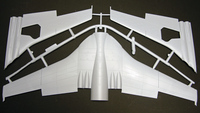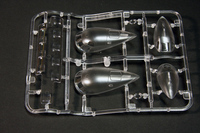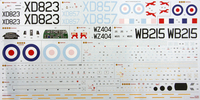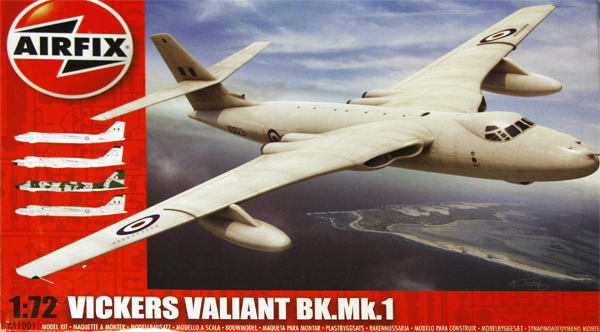
Airfix 1/72 Vickers Valiant
By Mike Whye
It's been many many years since Airfix made its 1/72 RAF Vulcan bomber which makes up into a good-sized model. Then Matchbox came out with its Victor which in real life was a bomber first and then an aerial tanker. So those were two-thirds of Britain's V-bomber force. Thus, I was pleased to see Airfix come out with a 1/72 Vickers Valiant Bk.Mk.1 about the middle of last year which rounded out the V-bombers if one was trying to build them all. Yes, Contrail had a vacu-form Valiant and Mach 2 issued an injection kit of one too but I thought if I wanted to build a Valiant, it would be the Airfix one. Yeah, I take the easy route.
The Real Thing
Designed to be a strategic bomber for Great Britain's Royal Air Force, the Valiant first flew in May 1951 although it did not begin operational duties until 1955 when it was the first of the V-bombers to enter the RAF. In all, 107 Valiants were made. Most were as the bomber although 11 also flew in a dual bomber-photo reconnaissance role. When fully in service, the Valiants formed at least 10 squadrons.In mid-1956, Valiant XD818 of 49 Sqdn. took off from Christmas Island as part of Operation Grapple and dropped Britain's first hydrogen bomb for a live test over Malden Island in the central Pacific.
Next in the Valiant's history was the Suez Crisis when Valiants from four squadrons attacked airfields in the Canal Zone, seriously damaging three of the seven airfields that were their targets. This was the last combat seen by any of the V-bombers for many years.
The Valiants of two squadrons began operations as aerial tankers in the late 1950s with all Valiants soon equipped for air-to-air refueling. With that, one Valiant became the first aircraft to fly non-stop from a base in England to Singapore in 1960, a mission made possible by in-flight refueling.With the advancement of Soviet anti-aircraft defenses against high-flying aircraft in the early 1960s, the Valiant, along with the Victor and Vulcan, had its role changed from high-altitude missions to low-level ground-hugging roles. Apparently the toil of flying low-level missions affected the wing spars of the Valiants and in August 1964 one Valiant was found to be suffering metal fatigue in many places when its rear spar failed although the aircraft was able to land safely. Inspections of other Valiants showed similar metal fatigue and their reliability was called into question. On Dec. 9, 1964 two Valiants flew the last missions of their kind and all were retired a month later. Only one Valiant survives today--at the RAF Museum in Cosford.
The Valiant was a four-engine medium-range bomber with swept-back wings. Two Rolls-Royce Avon RA28 Mk 204 turbojet engines were buried in the root of each wing with each engine delivering up to 10,000 pounds thrust. The plane's wingspan was 114 feet and it was 110 feet long. The top of its tail was 32 feet high. With a crew of two pilots, two navigators and an electronics warfare officer, the plane had a top speed of 567 mph, a range of 4,500 miles and a ceiling of 54,000 feet. Its payload was 21,000 pounds of conventional weapons or a 10,000-pound Blue Danube, an atomic bomb with a 10-12 kiloton yield. The Valiant carried no defensive armament.The Kit
Lately when Airfix has been boxing large kits, it's been putting them in oversized, very study boxes and this is no exception. Overall the molding of the pieces looks very fine, lines are recessed and appear to be a depth that pleases me (in other words, no Grand Canyons). Packed in a large plastic bag, the main sprues are made of a mdeium gray styrene and the clear sprue, in its own bag, is well-made too. I looked for ejection pin marks and sinks and am glad to report that I see none in locations that would show when the model is complete.
Assembly
The bomb bay can be assembled closed with a one piece representing the closed doors or you can chose to show the bomb bay open with either a conventional load of 21 1,000-pound bombs (each a single piece) or a Blue Danube bomb which is two pieces. The roof and the ends of the bomb bay are fair representations of the real things.
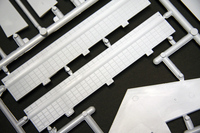
The two sets of intakes have upper and lower halves which are bound to create headaches for those who want to sand away those seam lines on the intakes' inner walls. Turbine blades are supplied to be placed at the rear of the intakes. At the back end of the engines are four exhaust pipes and sets of double engine nozzles; these pieces have no interior details.
The upper wing is one piece from wingtip to wingtip that snaps into a gap in the upper part of the fuselage. So if you're worried about the wing-to-fuselage connection and seams, don't.
The horizontal stabilizers are made as a single upper piece connecting to a single lower piece that inserts into the vertical stabilizer. While the rudder and flaps are molded in centered positions, you can position the ailerons and elevators as you want.
Landing gear can be built down or the landing gear doors can be glued shut for an in-flight display. If you build the landing gear down, you must note you'll need 22 grams of weight positioned just ahead of the cockpit. Also, the tires have slightly flattened sides, much better than the heavy-handed flattened sides often seen on tires.
The crew compartment access door can be positioned opened or closed but I wish a ladder had been provided. Although the real plane sat low to the ground, it wasn't so low that crew members could just climb in the open hatch without using a seven-step ladder.Each drop tank has two halves that clamp around a pylon forming a very solid sub-assembly to fasten underneath each wing.
There is one piece--#1 on the clear sprue--that may confuse you. Apparently Airfix will release another version of this kit to represent the reconnaissance version which carried up to 12 cameras in its bomb bay. This clear piece represents that windows situated in the holes that were cut into the bomb bay doors.
Options
Depending on the version you choose to build, you have two choices of the lower bulge that contains the bomb aimer's window and two versions of the teardrop-shapes canopy hood that cover the crew compartment. Likewise, you're provided with two upper nose halves to use with the appropriate versions.
Decals
Of course Airfix has provided a decal sheet to go with the kit so you can build one of those four versions. The two overall-white versions include XD823, No. 49 Sqdn. which flew from Christmas Island during Operation Grapple; and XD857 of No. 49 Sqdn. when it was based at Marhem, England. The camouflaged version is WZ404 of No. 207 Sqdn. which was also at Marham. The fourth version, Vickers Type 667, the second prototype of the Valiant, was overall aluminum. Decals include dozens of stencils which require an additional instruction sheet on how to place those.
Conclusion
If you're wanting to build a 1/72 scale Vickers Valiant, this is the way to go. I can't claim to know much about the real Valiants so I am unable to compare the model to the real ones other than by looking at photos of the real aircraft. From what I see, the model is a fine one to have on your shelves.The Airfix 1/72 Vickers Valiant retails for $56.99.


